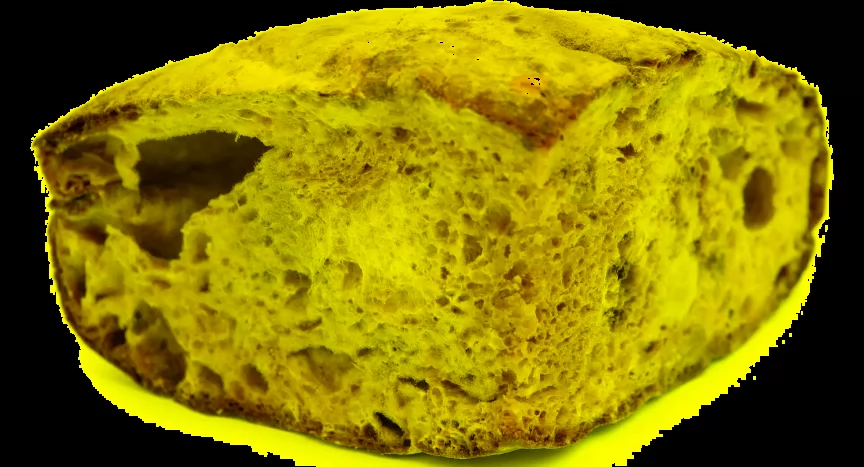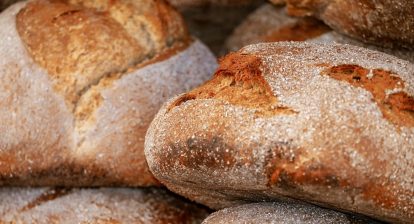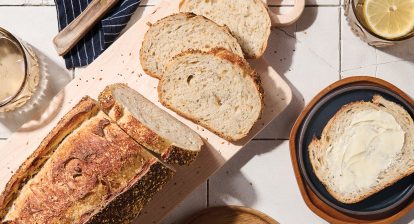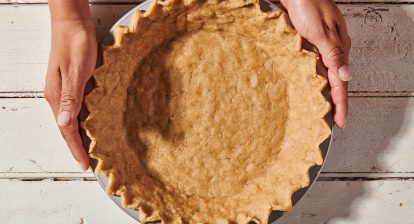Is there mold in your sourdough bread? Mold is a fungal growth that occurs and spreads on all types of organic matter. There are many different types of mold, each with its own distinct color, and while mold can be particularly unpleasant, it's important to recognize it so you can avoid it showing up over and over again! Here are some ways to tell if there is mold in your sourdough bread.

Table of Contents
Signs that sourdough bread has gone bad
All of us have experienced moldy bread at some point in our lives. Whether it appeared in homemade sourdough bread or store-bought bread, many of us have feared and MUST discard the bread immediately. If you're an avid baker, you may have had to throw away freshly baked sourdough bread simply because of a bad taste or unpleasant smell.
Some of the common signs that your buns are spoiled may include:
- Visible mold
- An unpleasant smell
- Bad taste
Visible mold
If your sourdough bread is starting to show signs of mold, throw it away!
While it is not entirely unusual for mold to appear on sourdough bread, it takes about 5-7 days for it to appear on homemade breads. Just remember to store the bread at room temperature and everything will be fine.
Don't cut the moldy part of the bread. While this may seem acceptable with other types of food such as fruit and hard cheese, it is completely unsafe for bread. Mold can easily travel under the surface of the bread; invisible to the naked eye.
Simply put, if one piece of bread is affected by mold, you better believe the rest of the loaf will be too!
Generally, mold on sourdough bread will be white and cloudy or blue-green.
An unpleasant smell
Freshly baked sourdough bread will give a wonderful sweet and slightly acidic flavor, with small hints of yeast. If your sourdough bread gives off an unpleasant smell, then it's time to throw your bread away!
Bad smells from your loaves can indicate invisible mold growth, especially if your loaves have been sitting on your kitchen counter for more than a week!
Bad taste
While moldy sourdough bread is one way to find out if your bread has passed, bad-tasting bread can also be a sign. If your sourdough bread tastes strange, it could be a sign of mold growth and you should throw the bread away immediately
However, if you are dealing with stale bread, then you don't need to throw the whole loaf away, in fact stale bread is perfectly safe to eat, although it can be a bit unpleasant. However, there are many ways to combat the great staleness of your sourdough bread, and one of them involves reviving the bread. You can learn more about extending the shelf life of sourdough bread by: how long does sourdough bread last?

Anti-mildew
Bread mold is often white in color, and although it may seem simple enough, it may not always be the case.
A piece of bread can be tossed with a dusting of flour as a finishing touch. While this can be appealing and delicious, it can get a little confusing when trying to tell the difference between bread mold and white flour.
Fortunately, you can run a few tests just to see if the white spots on your bread are either mold or flour.
- Delete it: The flour will have a powdery texture that will melt after washing. Although, if you are trying to remove the white mold, it will come off in pieces.
- Look at the color: Although flour and mold are white, they are not exactly the same shade. Flour will have a shiny appearance, while mold is a pale shade of white, tinged with green or blue.
- Monitor its growth: If it's flour, it won't spread on your bread. However, if it is mold, it will expand and grow all over your bread.
- Smell the bread: Plain sourdough bread will smell like nothing if it is not flavored. If the bread gives off a slightly musty smell, it's time to throw it away.
Stale bread vs spoiled dough
Stale bread it's nothing like rotten bread, in the sense that it's completely edible, although it may need a little revival before you can start eating it again.
Proofing occurs once the starch in the bread begins to dry out and return to a crystallized state, thereby hardening both the inside and the outside of the bread.
When the bread is freshly baked, the starch molecules absorb water and expand, making the bread softer. However, once the bread is removed from the oven, the water molecules quickly disperse and abandon the starch molecules. This causes the molecules to return to their original state and harden, meaning your loaves start to harden right out of the oven!
How to revive stale sourdough bread?
Get dry or stale bread? No problem.
Simply moisten the bread and then place the stale bread on a baking sheet right side up, or place it directly on the oven racks.
The water droplets on the bread will generate steam, penetrating the bread at every angle, effectively restoring its light and fluffy texture, as if it had just been baked!
How to extend the life of sourdough bread?
The easiest way to extend the life of your sourdough bread is by delaying the staleness and moldiness of the bread. Store your bread dough in a sealed container and place it in a cool, dry environment to prevent mold growth and staleness.
However, before you do this, you will need:
- Wait for your freshly baked bread to cool completely before storing it in its container. This ensures that any excess moisture is dissipated, effectively preventing mold growth.
- It's also important to wait for your bread to cool before slicing. This helps prevent moisture loss from cutting the bread too quickly, thereby speeding up the staleness process.
- Under no circumstances should you put your sourdough loaves in the freezer. This can cause them to go stale at an incredibly fast rate; much faster than if you were to store the bread at room temperature.
- If you want to keep your dough fresh for up to 3 months, simply wrap the loaf in plastic wrap and freeze. Freezing sourdough bread helps prevent mold and staleness, however, the quality of the bread will begin to deteriorate after 3 months of freezing, so be sure to use it within this time!
Although a frozen loaf of sourdough bread won't taste as good as fresh bread, it will taste amazing when prepared properly. Check out some steps to reheat frozen sourdough bread for that fresh-from-the-oven taste!

How to use stale sourdough bread?
If your sourdough bread is stale, don't worry, there are plenty of ways to fix the problem! You can make a variety of meals and appetizers, and they are all absolutely delicious. Your stale sourdough bread can:
- Slaughter of bread
- french toast
- Croutons
Slaughter of bread
Sourdough Breadcrumbs are super easy to make and taste absolutely delicious.
- Toast ½-inch slices of stale sourdough bread in a preheated oven for 15 minutes at 390 degrees Fahrenheit.
- Once the bread has cooled completely, add it to a blender.
- Blend until you are left with a crumbly powder.
Add this to your salads and soups for a nice sourdough bite.
French toast
If you haven't tried Sourdough French Toast yet, then you're missing out! The incredible combination of sweet and sour makes breakfast worth eating!
- Take your stale sourdough bread of choice and cut into 2 inch thick slices.
- Set the bread aside and make the egg mixture. Break 1 egg into a bowl and add 1 and a half spoons of sugar or 1 tablespoon of honey. Then add ½ cup of milk (you can also use oat milk for vegan or dairy-free versions). Mix these ingredients together, then toss your sliced bread into the mixture.
- Make sure your bread is completely dipped in the egg mixture until soaked and dripping.
- Meanwhile, heat a cast iron skillet and spray with cooking spray.
- Once the pan is nice and hot, drop your soaked bread into the pan.
- Cook on both sides until it turns a lovely golden brown.
- Serve with your favorite fruits.

Croutons
Sourdough croutons are another perfect treat with soups, salads and stews. They are crunchy, tangy and so irresistible!
- Cut your stale sourdough bread into 1-inch cubes.
- Add a little oil or melted butter, then season with salt and pepper.
- Place the diced cubes on a baking sheet and bake in a preheated oven for 10 minutes at 390 degrees F.
- Once they're crisp and golden, it's time to indulge!
Has your sourdough bread gone bad?
If your bread shows signs of mold growth, throw it away! Don't try to cut out the part with mold growing on it in an attempt to save what you have. Yes, sourdough bread can be precious, but once mold develops, unfortunately, it's game over!
On the other hand, if your sourdough bread is stale, simply revive it with a splash of water and a quick trip to the oven. Alternatively, you can use your stale sourdough bread and make a bunch of delicious treats!
If you are looking for mold in the beginning of your sourdoughhowever, check out my blog where I discuss that issue specifically!
Frequently asked questions about mold on sourdough bread
Is there mold in sourdough bread?
While sourdough bread can resist mold growth thanks to good bacteria, it can grow mold after it has been sitting on your kitchen counter longer than it should.
What does mold look like on sourdough bread?
Mold on sourdough bread can be white, or a light green with a bluish tint.
Why did my sourdough bread go moldy?
Mold often occurs due to neglect, cross-contamination with other foods, or weakened yeasts from forgotten foods.
Does sourdough mold quickly?
The natural yeasts in sourdough bread are mostly resistant to mold growth, however, this does not mean that sourdough breads are completely exempt from mold growth. For homemade sourdough bread, mold usually appears after 5-7 days of keeping the bread at room temperature.







